
Pattern grading is the process of turning base size or sample size patterns into additional sizes using a size specification sheet or grading increments. This can be done manually or digitally using computerized pattern drafting software. [1]

Pattern grading is the process of turning base size or sample size patterns into additional sizes using a size specification sheet or grading increments. This can be done manually or digitally using computerized pattern drafting software. [1]
Standard grading rules are based upon ergonomic measurements of the body, mathematically extrapolated or interpolated according to one of numerous pattern making systems. This is often chosen with an eye to the target market for a manufactured garment, in which one system or another prevails, according to consumer taste. Typically, the first pattern is developed in one size and is then graded up or down according to the chosen system, ensuring an optimum fit in all sizes. [2]
Grading is a necessary step that must be taken before outsourcing sewing, because sewists will require sets of specific patterns for cutting and sewing. (These are typically copied on to a durable medium such as oak tag paper or vinyl, and are referred to as "card sets" in the trade.) Grading will not create shape, but will only increase or decrease size of original shape. [3]
Historically, the science of grading developed with the advent of the tape measure, the introduction of scientific tailoring systems, commercial patterns and the mass-production of pattern-built clothing in the 19th century. [4] [5] : 130–131 To properly fit a pattern to a range of sizes, each piece needed to be graded, meaning systematically increased or decreased. A German mathematician Dr. Henry Wampen wrote two influential works, The Mathematical Art of Cutting Garments According to the Different Formation of Men's Bodies (1834) and Mathematical Instructions in Constructing Models for Draping the Human Figure (1863). Wampen introduced the principle of gradation via these works. [5] : 130–131 The Mathematical Art was translated into English by J. Happle-Hutcheson as Dr. Wampen's World Renowned System of Anthropometry as Simplified and Americanized in 1842, and remained in print into the 20th century [6]
Prior to this, sewing patterns were made to fit a specific individual, and were originally made on cloth, and only later on paper. A tailor or dressmaker recorded a customer's measurements on a thin strip of parchment and kept it with the pattern pieces, noting any changes in measurements and adjusting the pattern pieces accordingly. This required a good eye and many years' experience. Frequently an apprentice tailor's indenture specified that the apprentice would inherit the master's patterns upon the latter's demise, while enjoining complete confidentiality upon the former; patterns could also be passed down via family inheritance. [5] : 34–35 Early tailoring books, beginning in the sixteenth century gave advice on the quantity of material needed for certain garments, and gave simple diagrams of clothes. The reader could draft patterns by using these illustrations as a guide. One of the earliest illustrated guides is Libro de Geometrica Practica y Traca by Juan de Alcega, published in Madrid in 1589. [5] : 35, 39
By the beginning of the 19th century, shops in London were selling patterns: a full set of men's clothes patterns was five pounds, men's frock coat or lapelled coat five shillings six pence, and breeches or pantaloons three shillings. [5] : 34
It was not until the 1850s that sewing patterns were made available to a slightly larger, but still affluent, public. American women could obtain a paper pattern custom made by a dressmaker or could purchase a pattern through a women's journal.[ citation needed ]
The advent of large-scale production of graded, practical and easier to use sewing patterns came in 1863. Ebenezer Butterick mass-produced patterns printed on tissue paper. [7] Patterns were available for purchase in a variety of sizes, one size per package. In 1867, the Butterick firm began marketing its patterns via its own line of monthly and quarterly magazines.
It was not until the 1970s, when sales were lagging, that multi-size graded patterns became available. [8] [9]
There are three basic methods of pattern grading. There is not a superior method; they are all equally capable of producing a correct garment grade. These include:
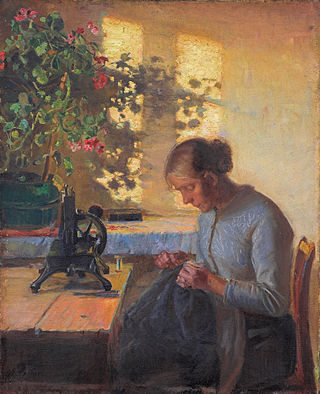
Sewing is the craft of fastening or attaching objects using stitches made with a sewing needle and thread. Sewing is one of the oldest of the textile arts, arising in the Paleolithic era. Before the invention of spinning yarn or weaving fabric, archaeologists believe Stone Age people across Europe and Asia sewed fur and leather clothing using bone, antler or ivory sewing-needles and "thread" made of various animal body parts including sinew, catgut, and veins.

A tailor is a person who makes or alters clothing, particularly in men's clothing. The Oxford English Dictionary dates the term to the thirteenth century.
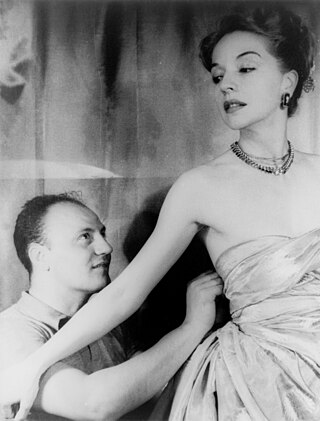
A dressmaker, also known as a seamstress, is a person who makes clothing for women, such as dresses, blouses, and evening gowns. Dressmakers were historically known as mantua-makers, and are also known as a modiste or fabrician.
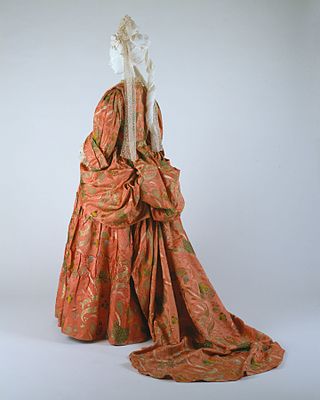
A mantua is an article of women's clothing worn in the late 17th century and 18th century. Initially a loose gown, the later mantua was an overgown or robe typically worn over stays, stomacher and either a co-ordinating or contrasting petticoat.
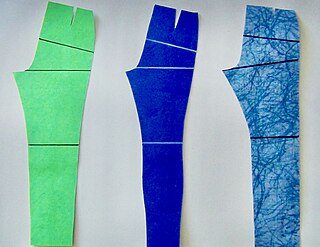
In sewing and fashion design, a pattern is the template from which the parts of a garment are traced onto woven or knitted fabrics before being cut out and assembled. Patterns are usually made of paper, and are sometimes made of sturdier materials like paperboard or cardboard if they need to be more robust to withstand repeated use. The process of making or cutting patterns is sometimes compounded to the one-word patternmaking, but it can also be written pattern making or pattern cutting.
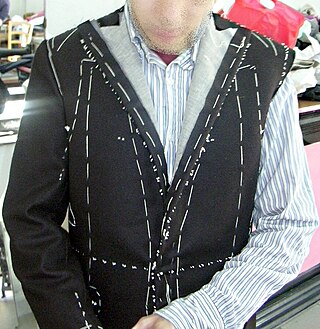
Bespoke tailoring or custom tailoring is clothing made to an individual buyer's specifications by a tailor. Bespoke garments are completely unique and created without the use of a pre-existing pattern, while made to measure uses a standard-sized pattern altered to fit the customer.

Ebenezer Butterick was an American tailor, inventor, manufacturer, and fashion business executive, born in Sterling, Massachusetts.

Mary Brooks Picken was an American author of 96 books on needlework, sewing, and textile arts. Her Fashion Dictionary was published by Funk and Wagnalls in 1957.
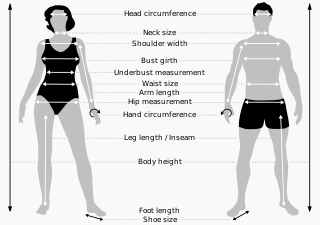
Clothing sizes are the sizes with which garments sold off-the-shelf are labeled. Sizing systems vary based on the country and the type of garment, such as dresses, tops, skirts, and trousers. There are three approaches:

Fashion design is the art of applying design, aesthetics, clothing construction and natural beauty to clothing and its accessories. It is influenced by culture and different trends and has varied over time and place. "A fashion designer creates clothing, including dresses, suits, pants, and skirts, and accessories like shoes and handbags, for consumers. He or she can specialize in clothing, accessory, or jewelry design, or may work in more than one of these areas."
Made-to-measure (MTM) typically refers to custom clothing that is cut and sewn using a standard-sized base pattern. Suits and sport coats are the most common garments made-to-measure. The fit of a made-to-measure garment is expected to be superior to that of a ready-to-wear garment because made-to-measure garments are constructed to fit each customer individually based on a few body measurements to customize the pre-existing pattern. Made-to-measure garments always involve some form of standardization in the pattern and manufacturing, whereas bespoke tailoring is entirely made from scratch based on a customer's specifications with far more attention to minute fit details and using multiple fittings during the construction process. All else being equal, a made-to-measure garment will be more expensive than a ready-to-wear garment but cheaper than a bespoke one. "Custom made" most often refers to MTM.
The term cut and sew is a manufacturing process used in the making of custom garments within the fashion industry. A whole piece of any type of fabric is first placed on a cutting table or run through a cutting machine. A garment piece or shape is then cut out, which is next sent for sewing through the garment assembly. A cut and sewn garment can include any custom measurements and fabric. This is not a pre-made blank garment. Cut and Sew manufacturing includes the following steps: Pattern Making, Maker Making, Cutting, Sewing, Finishing, and Quality Control.
A fit model is a person who is used by a fashion designer or clothing manufacturer to check the fit, drape and visual appearance of a design on a 'real' human being, effectively acting as a live mannequin. A person is selected to work as a fitting model primarily on criteria matching the desired measurement specifications of the designer or manufacturer. These specifications generally consist of height, bust-waist-hip circumference, arm and leg length, shoulder width, and a myriad other measurements as indicated by the garment type. This is the case whether the garments are for women or men of any size; the grading of construction patterns is often tested on a variety of fitting models to be sure that increases in size are translated accurately and evenly across the range.
A patternmaker is a skilled worker who produces patterns on paper or fabric for use in the clothing industry.
Sewing is the craft of fastening or attaching objects using stitches made with needle and thread. Sewing is one of the oldest of the textile arts, arising in the Paleolithic Era. Although usually associated with clothing and household linens, sewing is used in a variety of crafts and industries, including shoemaking, upholstery, sailmaking, bookbinding and the manufacturing of some kinds of sporting goods. Sewing is the fundamental process underlying a variety of textile arts and crafts, including embroidery, tapestry, quilting, appliqué and patchwork.

In sewing, a seam is the join where two or more layers of fabric, leather, or other materials are held together with stitches. Prior to the invention of the sewing machine, all sewing was done by hand. Seams in modern mass-produced household textiles, sporting goods, and ready-to-wear clothing are sewn by computerized machines, while home shoemaking, dressmaking, quilting, crafts, haute couture and tailoring may use a combination of hand and machine sewing.

A virtual dressing room is the online equivalent of an in-store changing room.
Zero-waste fashion refers to a fashion design strategy, that generates little or no textile waste during the production process, particularly focusing on the pattern making and cutting stages. It is a reaction to the high amount of discarded clothing items going into landfills around the world.
In sewing and patternmaking, ease is the amount of room a garment allows the wearer beyond the measurements of their body. For example, if a man has a 40-inch chest measurement, a jacket with a 40-inch chest would be very tight and would constrict movement. An ease of 3 or 4 inches might be added to the pattern, or more to enhance comfort or style. Ease is not generally included in sizing measurements. To use the example again, a man with a 40-inch chest will likely buy a jacket advertised as size 40, but the actual measurements of the garment will almost always be somewhat larger.
A sewing pattern is the template from which the parts of a garment are traced onto woven or knitted fabrics before being cut out and assembled. Patterns are usually made of paper, and are sometimes made of sturdier materials like paperboard or cardboard if they need to be more robust to withstand repeated use. Before the mid-19th century, many women sewed their own clothing by hand. Factory-produced fabrics were affordable and available in the early 19th century, but easy-to-use dress patterns and sewing machines for the home seamstress were not sold in the United States until the 1850s.